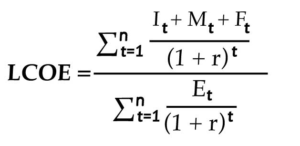Ceiling prices define the maximum supportJust like administratively set support, auction-allocated su... level and act to mitigate excessive producer rents in case of low or limited competition in the auctionAn auction is a market mechanism with the aims of allocating....
There are two main options for calculating ceiling prices: based on an assessment of generation costs (LCOE) or based on a calculation of opportunity costs. An LCOE-based technology specific approach is the best methodology to calculate ceiling prices. Compared to an opportunity cost approach, it provides a realistic production costs assessment.
In the LCOE-based approach, the ceiling price is set at or slightly above LCOE level. LCOE should be calculated from the perspective of a typical investor. Consequentially, the methodology should take the broader regulatory framework and transaction costsTransaction costs are referred to as all costs incurred in p... into account (taxes and tax exemption, market risk premiums, financing conditions etc.). As auctions increase risks for investors (as compared to administratively set supportJust like administratively set support, auction-allocated su...) the LCOE calculation should also account for this risk – otherwise the ceiling price may become too stringent and thereby impede competition.
Adjustment of ceiling prices on a regular basis is likely to be required as LCOE of renewables develop. In an auctionAn auction is a market mechanism with the aims of allocating... scheme, there are three possible procedures to adjust prices. First, an administrative authority could recalculate the LCOE and the ceiling price on a regular basis. Second, the ceiling prices could be indexed to economic indicators (such as steel prices etc.) and changed automatically or by discretion of the auctioning authority. Third, ceiling prices could be adjusted based on the auctionAn auction is a market mechanism with the aims of allocating... outcomes of previous rounds. The first option involves regular transaction cost but is well established in many EU Member States with feed-in tariffs, the second option requires higher transaction cost to set up the methodology and the third option requires some attention to avoid strategic bidding.
A suggested ceiling price calculation is given below.

LCOE = Levelised cost of electricity
It = Investment in the year t
Mt = Operations and maintenance expenditures in the year t
Ft = Fuel expenditures in the year t
Et = Electricity generation in the year t
r = Discount rate
n = economic lifetime of the system
